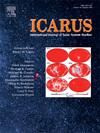New observations of topographic slumps in Valles Marineris, Mars: Investigating the role of recurring slope lineae
IF 2.5
2区 物理与天体物理
Q2 ASTRONOMY & ASTROPHYSICS
引用次数: 0
Abstract
Small-scale landslides, termed topographic slumps, are commonly co-located with seasonally active recurring slope lineae (RSL) on Mars. Previously identified topographic slumps initiated beneath or around the terminal points of RSL, suggesting that RSL activity may trigger slump formation. In this study, we conducted a comprehensive survey of HiRISE images spanning Mars years (MY) 29 to 37 in the southern mid-latitudes, northern mid-latitudes, and equatorial latitudes. We report eight newly identified topographic slumps that formed over the past 4 Mars years. Despite a comprehensive survey, these slumps were exclusively observed on slopes within Valles Marineris. While most of these slumps were co-located with RSL, two occurred on slopes lacking any detectable RSL activity. All slumps, however, formed on steep slopes (>27°) with inferred high sediment supply. We analyzed slump morphologies, seasonalities, and slope parameters to discuss potential topographic slump formation mechanisms. We suggest that if RSL are dry granular flows, gradual oversteepening due to debris accumulation beneath their termini could promote slumping. However, the limited number of topographic slumps relative to the widespread occurrence of RSL suggests that these features may be unrelated, or that unknown alternative conditions are necessary to initiate slump formation.
求助全文
约1分钟内获得全文
求助全文
来源期刊

Icarus
地学天文-天文与天体物理
CiteScore
6.30
自引率
18.80%
发文量
356
审稿时长
2-4 weeks
期刊介绍:
Icarus is devoted to the publication of original contributions in the field of Solar System studies. Manuscripts reporting the results of new research - observational, experimental, or theoretical - concerning the astronomy, geology, meteorology, physics, chemistry, biology, and other scientific aspects of our Solar System or extrasolar systems are welcome. The journal generally does not publish papers devoted exclusively to the Sun, the Earth, celestial mechanics, meteoritics, or astrophysics. Icarus does not publish papers that provide "improved" versions of Bode''s law, or other numerical relations, without a sound physical basis. Icarus does not publish meeting announcements or general notices. Reviews, historical papers, and manuscripts describing spacecraft instrumentation may be considered, but only with prior approval of the editor. An entire issue of the journal is occasionally devoted to a single subject, usually arising from a conference on the same topic. The language of publication is English. American or British usage is accepted, but not a mixture of these.
 求助内容:
求助内容: 应助结果提醒方式:
应助结果提醒方式:


